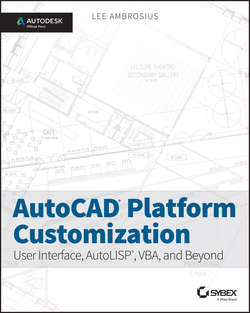Читать книгу AutoCAD Platform Customization - Ambrosius Lee - Страница 25
На сайте Литреса книга снята с продажи.
Part I
AutoCAD Customization: Increasing Productivity through Personalization
Chapter 2
Working with Nongraphical Objects
Defining and Managing Other Nongraphical Objects
ОглавлениеAll of the drawings you create should contain a standard set of layers and annotation styles to ensure they have a consistent appearance from one drawing to the next. There are other nongraphical objects that you should consider standards for based on the types or sizes of the drawings that your company creates. Just as I recommended placing the layers and annotation styles that you frequently use in your drawing templates, you might want to do the same for some of the nongraphical objects mentioned in this section, especially if you work on 3D models.
Because these nongraphical objects are less frequently used, I mention them here only briefly; you can find more information by using the AutoCAD Help system. Most of these nongraphical objects are supported on both Windows and Mac OS, but there are some limitations and I note some of those next.
Multiline Styles Multiline objects are used to create two or more parallel lines that might represent roadway, sidewalk, or utility offsets from a road. These offsets are defined as part of a multiline style. Although multiline styles are supported on both Windows and Mac OS, only the Windows version supports the mlstyle command, which allows you to create multiline styles directly from inside AutoCAD. On Windows and Mac OS, you can define multiline styles outside of AutoCAD by editing the acad.mln file with an ASCII text editor such as Notepad (Windows) or TextEdit (Mac OS).
View Styles View detail and section styles are used to control the appearance of associated detail and section views that are generated from 2D drawings created with AutoCAD and 3D models created with Autodesk Inventor®. You use the viewdetailstyle and viewsectionstyle commands to create and modify view detail and section styles. (This option is not supported on Mac OS.)
Views Panning and zooming in large drawings can become inefficient after a while, especially if you find yourself moving between the same areas of a drawing over and over again. Named views allow you to define a rectangular area of a drawing and give it a name. You can quickly return to that view by selecting its name from the Viewport Controls displayed in the upper-left corner of the drawing window. Named views are much more commonly used in 3D than 2D drawings to control the background of the current viewport. You use the view command to create named views. The Windows version of the command displays a dialog box, but the Mac OS version of the command is command-line–based only. Both versions of the command share the same options, with the exception of the Background and Shot Properties options, which are available on Windows only.
User Coordinate Systems (UCSs) All drawings contain a world coordinate system (WCS), which works well when you are drawing from a plan view. A user coordinate system (UCS) allows you to change the orientation of the working plane (X,Y) in addition to the Z-axis or placement of a drawing's origin. If you are drawing objects that are very far from the origin (0,0) of a drawing in 2D, adding ordinate dimensions, or using pattern fills, you might want to define a new origin to make entering coordinate values or controlling the pattern placement for a hatch object easier. UCSs are much more commonly associated with 3D modeling, though, because they allow you to align the UCS with the face of an object or change the direction of the Z-axis and the current working plane so that you can draw 2D objects at different angles in 3D space and then extrude them. The ucs and ucsman commands are used to create and manage named UCSs.
Model Space Viewports You can divide model space (using the Model tab) into more than one viewport and then save it as a viewport configuration. This approach is useful if you are working on a 3D model because it allows you to start a command in one viewport and switch to another viewport that has a different view to finish the command. It can be helpful when you are working on large drawings as well. You use the vports command to create named viewport configurations or restore the original single-viewport configuration.
Visual Styles Looking at 3D models in wireframe can make it hard to tell what is going on at times, and rendering your model can take some time based on the lighting, materials, and other rendering settings that are applied. Visual styles allow you to control a number of settings that affect the appearance of 3D objects. They can be used to show only the visible edges from the current viewpoint, apply colors of shading, and even make 3D objects appear semitransparent to see the objects beyond. Visual styles can be created and modified in AutoCAD on both Windows and Mac OS, but the process is slightly different. In AutoCAD on Windows, you use the visualstyle command to display the Visual Styles Manager, but in AutoCAD for Mac you use a combination of the Visual Style section on the Properties Inspector (properties command) when no objects are selected and the vssave command to save the changes to a visual style.
Конец ознакомительного фрагмента. Купить книгу
